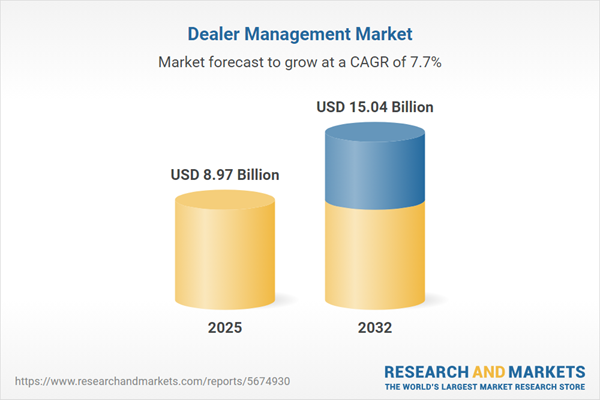Speak directly to the analyst to clarify any post sales queries you may have.
The dealer management market is undergoing transformation as organizations accelerate adoption of digital ecosystems. Senior leaders seek streamlined solutions that align with evolving operational needs and heightened regulatory oversight. Strategic integration, transparency, and partner collaboration are now central to effective dealer management.
Market Snapshot: Dealer Management Market Growth and Outlook
Advancements in enterprise digitization and growing service delivery requirements are driving significant expansion in the global dealer management market. The sector is set to advance from USD 8.33 billion to USD 15.04 billion between 2024 and 2032, representing a robust 7.66% compound annual growth rate (CAGR). This growth signals increasing demand for nimble dealer management systems across established and emerging businesses. Automotive, electronics, and industrial machinery verticals are at the forefront, leveraging comprehensive dealer management platforms to achieve agility and responsiveness within complex, digitized markets.
Scope & Segmentation in the Dealer Management Market
This report delivers an in-depth analysis of key market segments, adoption of enabling technologies, and vendor strategies, supporting confident executive decision-making. Dealer management platforms are central to achieving efficiency and transparency across distributed business environments, improving collaboration and supporting compliance throughout the value chain. Principal segmentation and scope areas include:
- Solution Type: Consulting, maintenance and support, training, and dealer management software each accelerate digital transformation and bolster compliance under evolving regulations.
- Deployment Mode: Cloud-based and on-premise choices allow organizations to select platforms that best fit technical infrastructure, internal governance, and security requirements.
- Organization Size: Modular platforms support phased adoption and tailored configuration, enabling businesses of all scales to pursue modernization at their own pace.
- Industry Vertical: Automotive (including passenger, commercial, and agricultural vehicles), electronics, and industrial equipment sectors each require tailored integration strategies based on unique operational demands.
- Functionality: Inventory control, CRM, scheduling, sales operations, warranty management, aftermarket services, and network distribution improve process visibility and workflow efficiency.
- Regions Covered: The Americas, Europe, Middle East & Africa, and Asia-Pacific display unique technology adoption trends and regulatory considerations, shaping localized market strategies.
- Leading Companies: Prominent industry participants include CDK Global LLC, Reynolds & Reynolds Company, Dealertrack Technologies Inc., Tekion Corporation, DealerSocket Inc., Dominion Dealer Solutions LLC, Auto/Mate Dealership Systems Inc., Autosoft of America Inc., PBS Systems Inc., and Frazer Computing Inc.
Key Takeaways for Senior Decision-Makers
- Dealer management platforms use advanced analytics to deliver real-time, predictive insights, supporting proactive responses to industry shifts.
- Integrated solutions for customer and sales management enable consistent, high-quality engagement across both digital and traditional channels.
- Flexible system configurations help manage compliance changes, reduce risk exposure, and ensure sustainable operational effectiveness.
- Enhanced collaboration between manufacturers, dealerships, and technology providers drives seamless integration and aligns services with evolving market needs.
- Support for open APIs ensures compatibility with existing enterprise systems and positions organizations for future scalability as requirements evolve.
Tariff Impact: Navigating Regulatory Shifts in 2025
Shifting U.S. tariffs are motivating organizations to reassess global sourcing and partner networks. These regulatory adjustments create new complexities for pricing, inventory management, and overall operations. Dealer management systems with embedded analytics provide the tools to adapt business strategies, optimize profitability, and safeguard customer relationships amid ongoing policy change.
Methodology & Data Sources
This report draws on direct interviews with executives, peer discussions among industry experts, and a thorough analysis of secondary data. An independent industry-led review process ensures accuracy and actionable relevance for senior decision-makers.
Why This Dealer Management Market Report Matters
- Empowers executives with evidence-backed frameworks to address digital transformation, guiding organizations through changing compliance and operational conditions.
- Supports comparative evaluation of technology investments and helps optimize vendor partnerships in a global market landscape.
- Enables organizations to benchmark digital adoption and refine strategic planning at each transformation phase.
Conclusion
Dealer management systems are fundamental to modernizing operational ecosystems. Enduring technology investments and collaborative industry partnerships position organizations for resilience and effective response in a dynamic marketplace.
Additional Product Information:
- Purchase of this report includes 1 year online access with quarterly updates.
- This report can be updated on request. Please contact our Customer Experience team using the Ask a Question widget on our website.
Table of Contents
3. Executive Summary
4. Market Overview
7. Cumulative Impact of Artificial Intelligence 2025
Companies Mentioned
The companies profiled in this Dealer Management market report include:- CDK Global, LLC
- Reynolds & Reynolds Company
- Dealertrack Technologies, Inc.
- Tekion Corporation
- DealerSocket, Inc.
- Dominion Dealer Solutions, LLC
- Auto/Mate Dealership Systems, Inc.
- Autosoft of America, Inc.
- PBS Systems, Inc.
- Frazer Computing, Inc.
Table Information
| Report Attribute | Details |
|---|---|
| No. of Pages | 186 |
| Published | November 2025 |
| Forecast Period | 2025 - 2032 |
| Estimated Market Value ( USD | $ 8.97 Billion |
| Forecasted Market Value ( USD | $ 15.04 Billion |
| Compound Annual Growth Rate | 7.6% |
| Regions Covered | Global |
| No. of Companies Mentioned | 11 |









